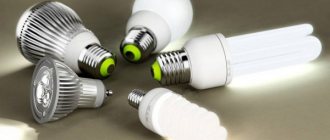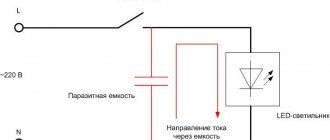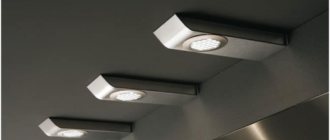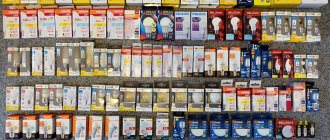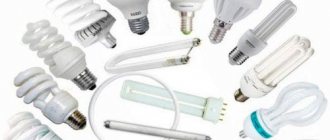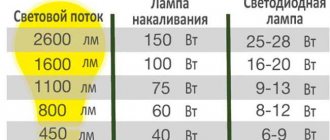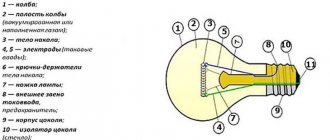Operating principle and design
Rotary dimmer for LED lamps
A dimmer is an element that allows you to smoothly change the intensity of artificial lighting, turn light bulbs on and off, and control light remotely. The adjustment is carried out by changing the voltage and, accordingly, the power of the device. This can be done by adding a load - ballast resistors, capacitors, chokes. In LED lamps, adjustment is made using dimmers.
Not every LED light source can be connected to a dimmer. To achieve stable lighting control, you need special controllers or devices with a PWM function. It is important to choose the right regulator for the light bulb, since the quality of the lighting change will depend on its circuitry.
The dimmer operates like a rheostat. Voltage or current changes as a result of changes in resistance. Nowadays, semiconductor regulators are actively used - triacs and dinistors, operating on the PWM principle.
The advantages of dimmers include:
- creating comfortable lighting at any time of the day;
- energy saving;
- reliability;
- smooth start;
- you can control several lamps;
- increasing the service life of lighting devices;
- ease of installation;
- possibility of synchronization with the “smart home” system;
- creating unique visual effects.
Saving electricity is the most important advantage of dimmable devices over conventional light sources. By adjusting the light level, the lamp will not burn at full power all the time and, accordingly, consume a large amount of electricity. This use also leads to an increase in the service life of the lamp.
Disadvantages:
- high price;
- incorrect choice of regulator can lead to malfunctions;
- cheap devices can cause interference;
- sensitivity to elevated temperatures;
- low efficiency in night mode.
Regulators for 220 V and 12 V have design differences. The simplest mechanisms that craftsmen can make at home perform the function of changing the intensity of light. Modern models have wider functionality - for example, the “Sleep” function, in which the brightness is maintained at 30% of full. There is also a “good morning” function when the intensity increases, or a “good night” function when the light becomes more subdued.
Light controllers are used in different areas. In home lighting, in billboards, for entertainment purposes. Adjustable lamps are used in office lamps VG SKUL 1200-36 W.
Dimmers are an important component of the smart home system. An important function of the regulators is the emergency lighting system. When operating from a battery or battery, the service life increases by reducing the brightness.
What is a dimmer and why is it needed?
A dimmer is an electronic device capable of regulating power by regulating the voltage supplied to the load. The definition is very dry and boring, let's explain the principle of operation in simpler language.
Power depends on the voltage and current in the load. This means that if you reduce one of the components, the power will also decrease. Voltage and current are related by Ohm's law, which means you can reduce the power of your device (brightness of the lamp) by increasing the total load resistance. That is, use ballast resistors, chokes or capacitors.
Ballast power absorbers - convert excess energy into heat and have low efficiency. To regulate the power of the device, in our case the brightness of the light bulb, you need another device - a dimmer.
Is it possible to connect LED lamps via a dimmer? Can. But not everything will be consistently regulated. Here you need special LED lamps for dimmer.
LED lamps, adjustable with a dimmer , are suitable for use with any regulator. But there are some nuances in the difference between the type of voltage regulation. This is determined by the dimmer's circuitry; the differences will be described in detail in the following sections of the article. The type of dimmer determines how well the LEDs will be regulated.
Which LED lamps can be used with a dimmer? In this matter, everything is extremely individual. It all depends both on the circuit of the light bulb itself and on the circuitry of the regulator. In general, so-called dimmable LED lamps are excellent.
Types of dimmers
Classification of controllers is made according to various criteria: type of voltage in the circuit, type of control signal, installation method, design.
Based on the network voltage, light controllers can be divided into two groups:
- for alternating voltage 220 V;
- for constant voltage on LED strip 12 V.
Based on the type of control signal, dimmers for LEDs are distinguished:
- analog;
- digital;
- digital-analog.
There are several types based on the installation method:
- modular, which are mounted on a special DIN rail in the distribution panel;
- remote ones, which are mounted in a chandelier;
- wall-mounted, which are installed instead of a switch.
By control method:
- rotary - adjustment is carried out using a handle;
- keyboards – control is performed using buttons;
- rotary-push - adjustment is made by pressing buttons and turning the knob;
- touch – models with various sensors;
- remote – controlled by remote control via Wi-Fi, radio or infrared.
The most expensive are touch-sensitive light controllers. These are modern devices that can be controlled by voice commands, movements, or clapping.
Types of devices by installation method
To solve various problems and simply to increase comfort, modern brightness controllers can be mounted in different places. In addition, this feature makes them more convenient to operate.
Dimmers are as follows:
- invoices;
- built-in;
- modular.
The easiest to install are surface-mounted devices, which are similar in shape and size to conventional switches and are quite capable of replacing them. Their installation procedure is also similar, and the control principle is similar.
The use of a radio signal allows control from any corner of the room, building, and, if necessary, from outside them
The main feature of all kinds of built-in dimmers is that they are mounted in a distribution box or a specially made niche. As evidenced by the very name of this variety.
Modular devices are designed for installation in electrical panels on DIN rails. This feature is due to the fact that they are large in size and high in power. Which in everyday life allows them to be used to control several supply lines at once.
The future user should remember that modern dimmers, regardless of the type of installation, are connected to or built into a circuit between the LED strip itself and its power supply.
That is, there cannot be another option, which must be taken into account for ease of installation and management. It is also common to see regulators divided according to the number of working channels and the protocol used.
Any built-in dimmer does not have high aesthetic properties, but its functionality is not inferior to its overhead counterparts
But, in most cases, this is of little interest to the ordinary user, since structurally complex models are rarely used in domestic conditions, small commercial and office premises due to their considerable cost.
Criterias of choice
LED light sources can be dimmable or non-dimmable. This must be taken into account when purchasing. Regulators should be selected taking into account the following aspects:
- Possibility of adjusting the light source. You cannot install a dimmer on an unregulated LED lamp. This will cause damage that is not covered under warranty.
- The number of light sources that the dimmer will control. For one light bulb, it is enough to purchase a low voltage regulator.
- Light bulb power and minimum dimmer load level. For most regulators, the minimum load is 20-45 watts. This power can be achieved using 2-3 LED lamps connected to a 220 V network.
- Total load on devices. The dimmer power should exceed approximately 30% the total connected load.
- Voltage. For lamps you need a dimmer that works with a 220 V network, and for strips - for 12 V or any PWM regulator.
When choosing a regulator, you should give preference to proven, well-known brands. These include Schneider Electric, Legrand, Makel, ABB and others. A low-quality product of unknown origin can lead to lamp failure. You also need to buy devices from specialized stores. There the seller will help you choose a dimmer, give advice on connection and tell you about the warranty conditions.
How to adjust LED lighting
What light bulbs can be used with a dimmer? When mainly incandescent lamps were used for lighting, everything was simple - a regular dimmer could easily cope with adjusting the brightness.
Incandescent light bulbs were replaced by energy-saving fluorescent light bulbs and could not be dimmed at all. Of course, there were electronic ballasts for tubular fluorescent light bulbs with dimmable capabilities, but they were extremely rare and they were expensive.
Now energy-saving lamps are being replaced by LED lamps. The process of emitting light quanta, although complex, is, from a regulatory point of view, perhaps simpler than regulating gas-discharge light sources.
Dimmable LED lamps - what are they?
What does dimmable LED lamp mean? This is a light bulb that can be dimmed using ANY dimmer that is designed for alternating or direct current (depending on the type).
Its power circuit includes functions for changing brightness, depending on the supply voltage. Dimmable LED lamps work with dimmer circuits like the one shown above.
The network dimmer regulates the supplied voltage. This means that at any voltage values, within the range specified by the manufacturer (it is indicated on the light bulb box), the lamp circuit will strive to maintain the specified current. Brightness in turn depends on current.
Regular LED lamps cannot be adjusted; at best, they will simply turn on and off; at worst, they will burn out at low values set on the dimmer.
The cheapest LED lamps have a quenching capacitor. Even if they are regulated, it will be only within very narrow limits, which means they are also not suitable. For an example of dimming conventional LED light bulbs, watch the video.
Dimmable LED lamps 220 Volt
Adjusting the brightness of 220V LED lamps is difficult because there is a current stabilization circuit installed on a specialized driver. Its task is to stabilize the output current to ensure a uniform and long-lasting glow of the LEDs, regardless of the supply voltage.
Conventional LED lamps are not very dimmable. To choose the right LED lamp for a dimmer, you need to carefully study the description and symbols indicated on the box and body of the light bulb.
LED lamps with dimming can be recognized by the inscription: “for dimmer”, “adjustable” or something similar; perhaps a conventional image of a dimmer will simply be drawn, as in the examples below.
Is it possible to adjust the brightness of LED lamps running on DC?
The photo shows a led dimmer for a 12V LED strip. Let's figure out how such a dimmer works with LED lamps.
For DC circuits, the operating principle of the regulator is different. Here, a bipolar or field-effect transistor is used as a metering element, and a pulse generator with a variable duty cycle is used as a metering element.
The method of this control is called pulse width modulation (PWM). To understand how this works you need to look at the graphs.
Vcc is the voltage at the DC dimmer input, Vaverage is the output voltage. You can see how the average voltage changes. As the pulse duration increases and the pause length decreases (we increase the duty cycle), the output voltage increases.
Above is a circuit diagram of a “PWM dimming controller for LED lamps on NE555.” It can act as a device for dimming LEDs. It works like this:
NE555 is a timer, connected here in the pulse generator mode, the frequency and duration of which is set by an RC circuit consisting of R2, potentiometer R1 and capacitor C5, as in the previous circuit, the potentiometer regulates the charging rate of the capacitor, and the pulse width is formed in accordance with the charging speed.
Initially, the circuit produces symmetrical pulses, that is, the pause length is equal to the pulse length. But thanks to the presence of a potentiometer and a chain of two diodes VD1 and VD2, the capacitance is charged and recharged through different resistances of the potentiometer, or rather through different pairs of its contacts.
Therefore, PWM adjustable pulses are generated with a constant frequency, but a variable duty cycle.
If you use it in a car or for dimming an LED strip, you can eliminate the additional 9 volt power supply based on the 7809 linear regulator and supply power to the first point after it in the circuit.
But here are photos of a homemade dimmer for LEDs, if necessary, you can copy the location of the tracks and repeat it. Or assemble it on a breadboard.
A video of how dimming LED lamps works using this circuit, using a side-glow strip as an example, is located below.
Using this circuit, it is possible to dim 12V LED circuits and any other DC load. For example, adjust the speed of revolutions of a PC cooler, brushed motors, heaters, in general, anything you can think of. In one of the articles we already talked about making an LED dimmer with your own hands.
Light control method
AC dimmers differ not only in design, but also in the method of adjustment. These include:
- dimmer with leading edge cutoff;
- with trailing edge cut-off.
The first ones are the cheapest and simplest devices. The remainder of the half-wave is applied to the load, its first half is cut off. When turned on, noise occurs that may interfere with the operation of household devices. Such dimmers are used for special LED lamps. You can tell if a light bulb is suitable by looking at the labels on the packaging.
The second type is suitable for a larger number of lamps and works without interference. The adjustment is carried out better, but within a certain range, not from scratch.
Lamps with built-in brightness control are placed in a separate group. They include an LED matrix, a driver, a bulb and the regulator itself. There is no need to install additional dimmers for such lighting devices.
When is a regular LED lamp dimmed?
Sometimes a regular LED lamp can still show “signs” of dimming, even if it is not designed for this. This applies primarily to cheap Chinese copies.
They are equipped with the most primitive driver, without any protection against current overloads and voltage surges. It is this design flaw that allows them to dim randomly.
Moreover, within very narrow and limited limits. For other LED lamps, this is basically impossible. Therefore, it is better to always look for models with the Dimmable icon in stores.
By the way, the opposite rule also applies here - if you are not going to adjust the brightness of your lamp, then there is no point in overpaying and purchasing dimmable copies. Keep this in mind.
There are lamps that seem to be dimmable, but poorly. At the same time, some craftsmen try to cheat and include one ordinary incandescent lamp in a chain of parallel-connected, poorly regulated LED specimens.
This circuit greatly affects the overall resistance, especially when the temperature of the tungsten filament changes. This feature allows, in certain cases, to expand the dimming range of LED light bulbs.
However, the service life of such a circuit and its individual elements will be far from that declared by the manufacturers. Most lamps may simply fail soon.
Self-installation of the regulator
You can install a dimmer for 220 V LED lamps yourself. The master must have minimal knowledge in the field of electrical appliances and follow safety precautions.
Step-by-step installation algorithm:
- Power outage in the house. Checking the presence of voltage using an indicator.
- Studying the dimmer circuit.
- Loosening the bolts, installing the regulator contacts into the circuit connectors. It is important not to mix up the wires and follow their markings. Typically white is the phase and blue is connected to the load.
- Tighten the bolts after installation to ensure good contact.
- Installing a dimmer in a socket box.
- Installation of the protective housing and button.
Afterwards, you can turn on the electricity and test the assembled system. By the smooth change in the backlight, you can judge that the assembly was carried out correctly.
Installation may vary slightly for different types of dimmers and devices from different companies. Be sure to read the instructions included with the kit.
Conclusions and useful video on the topic
The first video will give a person the opportunity to get to know the regulators better and learn some of their features:
The following video provides information that allows you to better understand the advantages of remote control and understand how it is performed:
The video will help you figure out how to improve the functionality of LED strips and learn about the advantages of sensors:
A dimmer, designed to regulate the brightness of strips, is a practical device that can significantly reduce energy consumption in any room, as well as increase comfort in it. But for this, a person needs to make the right choice and not forget that the desired result will be obtained only by purchasing a quality product.
Please write comments, ask questions, and post photos in the block below. Tell us about how you selected a dimming device for LED strip lighting in your own home/apartment. It is possible that your recommendations will be useful to site visitors.
Possible installation errors
Installing a dimmer is not difficult, but beginners can make a number of mistakes. Typical problems include:
- using a dimmer at elevated temperatures - the optimal maximum temperature is 27-30 degrees;
- the load must be at least 40-45 V, otherwise the service life of the dimmer and lamp will decrease;
- incorrect choice of dimmer for a specific light bulb;
- using a regulator for an LED strip in a lamp and vice versa.
The last 2 mistakes are the most common. Before starting installation, you need to make sure that the dimmer fits the light bulb, and only then begin the installation.
The best manufacturers on the lighting market
Not all manufacturers produce dimmable LED lamps, and their range is not very wide. But those that exist are still sufficient, because the popularity of adjustable lighting has not yet gained full strength.
LED lamps from Uniel
The manufacturer Uniel produces dimmable LED lamps as part of the Cristal Dimmable and Palazzo Dimmable series. Both series devices can be used with dimmers designed for standard incandescent light bulbs. The CRI index is ≥ 80Ra. Brightness adjustment is carried out within 10-100%.
The range of input voltage values at which the illuminators can operate is quite wide - from 40 to 250 V. The bulb of the devices is matte.
Lamps of both series are produced in two color temperatures. Service life is approximately 30,000 hours, 36 month warranty
Products from the Cristal Dimmable range have a traditional aluminum alloy body with an E14 base. The LEDs are located in a bulb on metal petals and create a wide angle of light transmission - 360°.
The Palazzo Dimmable series devices are available with a uniquely shaped body that has four channels for ventilation. They provide additional ventilation to the internal structural elements, extending the service life of the device.
They are made for reflective and spot light lamps, as well as in the form of an Ilyich light bulb, candle, or ball. Base types used for the production of dimmable luminaires - GU10, GU5.3, E14, E27. Light intensity - 500-600 lm, power - from 5 to 7 W. The luminous flux is slightly narrower than that of the previous series - 240°.
Wide selection of Philips LED lamps
As part of the MASTER series, the manufacturer Philips produces dimmable LED lamps in pear- and spherical shapes, in the form of candles. The range also includes dimmable reflector lamps (Master LEDspot) and accent lamps (Master MV).
Dimmable illuminators produced using filament technology (Classic and LEDclassic series), the so-called Edison lamps, have LED filaments that resemble the luminous spiral of a traditional light bulb. They shine brightly and last longer than usual, but much less than other LED models - only 15,000 thousand hours
If when dimming a conventional LED lamp the light remains cold after decreasing the intensity, then with the DimTone function the lighting becomes warmer as the brightness decreases. The same effect is observed when dimming halogen light sources and traditional incandescent lamps. This function is used in some models of the MASTER series.
AirFlux technology involves a hidden ventilation system in which dimmable LED lamps last longer - up to 40,000 hours. Used only in some models of the Master LV series.
Based on energy efficiency levels, Philips products are divided into classes from A to A++. The most economical devices are produced under the names Master MV Value, LEDclassic.
Our other article provides more detailed information about the types of Philips LED light bulbs, their pros and cons.
LED products from Gauss
Gauss produces a fairly wide range of lighting equipment, including dimmable lamps. The products are distinguished by a wide input operating voltage of 185-265 V, with a high index of Ra>90.
Different models are produced in two color temperatures - 4100 and 2700 K. Operating time is 35,000 hours
Dimmable lamps are available in the following types:
- Filamentous . These are devices in the form of a candle and a ball, with a power of 5 W. The luminous flux values are 420 and 450 lm. The warranty is provided for 3 years.
- Soffit . They are produced with a base GU5.3, GU10, with a power of 5 W, a light flux of 500 and 530 lm. Product warranty - 3 years.
- Capsule . They have a G9 base, the light flux ranges from 280 to 300 lm, and the power is 3 W. Warranty period - 1 year.
We recommend that you familiarize yourself in more detail with the specifics of the design of Gauss light bulbs, their technical characteristics, as well as the pros and cons according to reviews from owners.
Separately, it is necessary to say about lamps with step dimming function of the Gauss Step Dimmer series. They have a completely different operating principle and cannot be classified as classic dimmable lamps.
They are not suitable for connection to a dimmer, as they are equipped with elements for adjusting the brightness already built into the base. That is, their work is not compatible with dimmers. They can operate in an electrical network with voltage standards of 180 - 240 V.
They are produced in the form of a ball, a candle, in the form of an incandescent lamp, with a stated power of 10 and 7 W, in two color temperatures - 4,100 and 2,700 K. Thanks to the improved technical characteristics, the warranty period is 3 years.
A “smart” lamp not only allows you to set a comfortable lighting intensity, it also uses energy economically
The device is controlled using a conventional switch, and adjustment occurs step by step, changing the brightness from 15% to 50% and 100%. Each flip of the switch changes the brightness of the light in three stages, the fourth stage being off.
Making your own dimmer
The simplest dimmer can be assembled with your own hands. To do this you will need:
- constant and variable resistor element;
- non-collar capacitor;
- triac;
- copper wire;
- dinistor;
- textolite board;
- soldering iron
All electronic components must be installed on the board according to a dimmer circuit: when current flows from the resistor element to the capacitor, charging will occur and voltage will be supplied to the lamp. The components must be connected to each other using soldering. You need to make holes on the board that will serve as leads. After assembly, you need to test the assembled dimmer.
Compatibility is always an issue
A consumer interested in using brightness control equipment should know that he will not only have to buy the necessary system components, but also match them together. Often there is a problem of inconsistency between the dimmer and the purchased LED lamp.
This happens due to the fact that there are a large number of electronic circuits for power drivers for lighting devices and control devices on the market.
Products of any domestic, European or Chinese manufacturer have the right to have a voltage threshold unique to them for inclusion. Also, incompatibility can lead to the fact that the range of adjustments is narrowed, and significantly.
For example, there are LED lighting devices that can turn on and operate even at 5% of the rated power. An incorrectly selected dimmer will only be able to control them within 40-100%. This will significantly reduce the functionality of the process.
The dimmer control panel can provide a radio or infrared signal. The first option is more functional, the second is cheaper, which is why it is the most popular
This feature will lead to the fact that the consumer will not save enough energy or will not be able to provide himself with the expected level of comfort. This is also a significant drawback. Other signs of malfunction may also appear.
The most common are the following:
- The power driver of the existing LED lamp makes loud noises that are unpleasant to the user during operation or cannot start the lighting device.
- The maximum voltage at the output of the dimmer does not reach the required 220 Volts, which makes it impossible to use the light bulb at full power.
- Short-term bright flashes when the lighting device is turned on, the duration of which usually does not exceed 1 second.
- Various interruptions in the functioning of the regulator itself, which will not allow you to effectively control LED lamps.
All of the above points indicate that the selection of equipment should be done carefully and competently.
The best models for incandescent lamps
Let's give a few examples of popular devices in different price categories, making up a kind of top four.
Universal dimmer DELTA from Siemens
The series includes both push-button and key-based dimmers. Easy to install and operate, the device can be used even with significant loads applied to the lamps.
The DELTA dimmer from the largest German manufacturer has a classic design and excellent quality. The device is made of high-quality plastic that is resistant to mechanical damage
The devices are suitable for various types of light sources, including incandescent lamps. Some modifications included in the line have additional functions.
These include, for example, the ability to remember the light level set the previous time it was turned on, or the ability to adjust the flow of light from different places in the room.
Celiane dimmer from Legrand
The Celiane series from the famous French manufacturer combines dimmer models compatible with various lamps, including incandescent devices. The line includes products designed for total power from 300 to 600 watts.
The models are made in four exquisite shades: white, ivory, titanium and graphite. In addition to the usual ones, waterproof modifications with a high degree of protection are also presented.
Of interest is the intelligent version of the device, thanks to which a smooth decrease in lamp power is available over an hour or stepwise adjustment of light intensity.
Rotary push dimmer from ABB
Dimmers 651500842 with a rotary-push mechanism are suitable for use with incandescent lamps with a power of 60-400 W.
Devices in this series, made in original colors, are made of especially durable plastic and metal alloys that are resistant to corrosion and deformation.
The kit for the ABB 651500842 dimmer also includes a pad and a support used when installing the product on vertical surfaces
The device connection diagram allows you to connect a switch to it. This makes it possible to turn on and off the lights from two different locations, but control access is only provided from the main device.
To turn on the lamp, you need to press the knob, turning which you can increase or decrease the brightness of the lighting.
When you turn off the device, it will remember the last position of the button, so the next time you turn it on, the brightness of the light will be set automatically.
Lezard Mira dimmer
The mechanical device is designed for a load not exceeding 800 watts. The adjustment is carried out by rotating the round knob: this allows you to change the resistance, which leads to an increase or decrease in the brightness of the lamp.
The device is housed in a housing that is standard for this type of electrical fittings. Its design allows you to easily connect the dimmer to already installed lighting circuits.
The advantages of the model include ease of use, long service life, and budget price.
How to choose
If you are planning to make lighting using SDL, you should immediately purchase a light controller, thanks to which you can adjust the brightness of the light. But in order not to make a mistake in your choice, you should pay attention to several criteria:
- Power, it should be 15-20% more than that of the light board. But if in the future it is planned to increase its length, then it is necessary that the regulator’s power reserve is 30 percent higher than that of the light board, and at the same time do not forget that a reserve is necessary, which should be up to 50%, in this way premature temporary wear of the devices can be avoided .
- The voltage must be identical for both parts.
- The number of channels, which will depend on the type of SDL. For example, for monochrome, single-channel ones are used, for RGB or RGB+W, multi-channel regulators are needed.
- The design can be hidden or overhead, in this case it all depends on the wishes of the user.
- Control, in this case, everything also depends on the preferences of the person installing this type of lighting. But it is worth knowing that devices with touch and remote control are more expensive.
- The presence of a function, but here you need to understand that the principle of the more, the better will not work, since you will have to pay extra for additional features.
When selecting a regulator for LED strips, you need to take into account all the points in order to prevent rapid failure of the structure and create convenient conditions for use.
"Dimmer" with a fixed brightness level
Resistor value 100-500 kOhm, power 1-2 W.
This is not even a dimer, since there is no PWM controller here. But it’s ideal for those who picked up a soldering iron for the first time.
Please rate the article. We tried our best:)
Did you like the article? Tell us about her! You will help us a lot :)
Connecting a dimmer to LEDs with your own hands
To connect the dimmer yourself, you only need the purchased device, a special torque wrench and any convenient cutting tool for stripping wires.
Step-by-step instructions consist of three stages:
- Before starting any installation work, be sure to turn off all electricity in the house.
- Next, you should strip the wires on the device and connect them in such a way that the phase wire is installed in the terminal called L, and the second is connected to the connector called N.
- At the final stage, these wires should be clamped and all existing bolts should be tightened, putting on a special frame.
How to make it yourself
If you are at least a little familiar with a soldering iron, then making the device yourself will not be too difficult. To work you will need the following items:
- two resistors (variable and constant);
- wires;
- non-polar capacitor;
- triac and dinistor.
All subsequent actions are carried out based on the basic diagram provided below:
Using a variable resistor, current is supplied to the built-in capacitor. Thus, the capacitor itself is charged and the light bulb begins to light.
To assemble the dimmer, all parts should be connected to each other as shown in the diagram. At the final stage, all ends of the elements used must be soldered to copper wires, having previously carried out mandatory degreasing.



